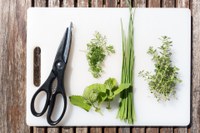Prairie Fare: Add Some New Flavors to Your Menu
(Click an image below to view a high-resolution image that can be downloaded)
By Julie Garden-Robinson, Food and Nutrition Specialist
NDSU Extension
“Do you know what’s in the sauce?” I asked the server.
“Do you not like it?” he asked.
I need to adjust my facial expression, I thought to myself.
“Oh, I like it a lot. I’m just wondering what the ingredients are,” I responded with a smile.
“I am not sure, but I will check with the chef,” he said.
I was at the Hyatt Regency Hotel in Crystal City, Va., at a national Extension conference, having lunch with a colleague. I was enjoying crab cakes with a tasty green condiment.
I pondered the flavors of my entree. A food and nutrition specialist always likes to know what she is eating, and the menu with the description was no longer in front of me. A couple of minutes later, our server returned with the chef following him.
“He brought the chef!” I whispered to my companion. Now this was service at the highest level.
Chef David explained the ingredients in the remoulade (pronounced “rey-muh-lahd”) sauce, which included mayonnaise, lemon juice, fresh chopped tarragon, curry powder and chopped capers.
Capers, by the way, are flower buds that grow on the caper bush in the Mediterranean area, as well as Asia and Africa. Typically, these flavorful buds are sold pickled in jars in some grocery stores.
He offered to email the recipe, and we supplied our email addresses gratefully. When I received his email, I chuckled. The kitchen staff thought I was a food critic. I thanked Chef David and explained that part of what I do is write a column about food, and I asked him if I could share the recipe. He graciously agreed.
You may not have tried a similar French-inspired recipe, but trying some new foods is a worthy goal. If you tend to stay with the same flavors in your cooking and dining, set a goal to be a little adventuresome. Flavor is the No. 1 reason that people choose the foods that they do, although I hope they consider nutrition sometimes, too.
You may find that having a smaller amount of a satisfying, flavorful food can lead to more moderate portion sizes. Be sure to slow down and savor each bite, too.
According to a 2018 food trends article in Nutritional Outlook magazine, consumers are increasingly interested in exotic spices from around the world, along with flavorful herbs. Consumers also like familiar flavors with an upgraded new twist.
For example, who had heard about sriracha a few years ago? Now it’s readily available. Foods with applewood or hickory smoke flavor are increasingly popular, too.
Have you tried any new flavor profiles lately? Put your spices to use and consider growing some culinary herbs this summer. If you lack garden space, consider your windowsills. Several herbs, including basil, parsley, marjoram, chives, mint and rosemary, are well-suited for growing in pots in a sunny window.
Herbs add flavor and negligible, if any, calories and other nutritional value. Many people find they can cut down on the amount of salt and fat in their recipes when they add herbs.
See the NDSU Extension publication “Harvesting Herbs for Healthy Eating” at https://tinyurl.com/NDSUHarvestingHerbs to learn more.
Hats off to Chef David, Executive Chef Paul and all for sharing the remoulade sauce recipe. If I were a food critic, I would compliment the entire kitchen staff on the high-quality, flavorful and unique food and comfortable ambience of the restaurant. I’d also compliment the servers for their attentive service throughout my stay.
Lemon Tarragon Remoulade Sauce (Compliments of the Hyatt Regency, Crystal City, Va.)
1/8 c. lemon juice, freshly squeezed
1/8 c. sherry vinegar
3 pinches curry powder
3 c. mayonnaise
1/4 c. Dijon mustard
1/4 c. capers, drained and chopped
1/8 c. tarragon, leaves chopped
Kosher salt (to taste)
Black pepper, freshly ground (to taste)
Water, cold (as needed)
Whisk the lemon juice and sherry vinegar with the curry powder to “bloom” the color and flavor throughout the mixture. Allow the mixture to sit for 10 minutes before the next step. Whisk in the curry and juice mix with the mayo and Dijon mustard until smooth and consistent. Gently fold in the capers and tarragon into the mayo/curry mixture. Season the remoulade with salt and pepper. Adjust the consistency to your desired preference with the cold water.
Chef’s notes: This sauce can be made ahead of serving and kept up to three weeks in the refrigerator. This sauce is a modern twist on a classic sauce that was developed for seafood, but this sauce is very versatile as a spread for a deli sandwich, a dressing for a tuna salad (thin out more with water), or a sauce for roasted fish or even char-grilled chicken. It can stand alone and be enjoyed as a snack with crackers and some wine.
Makes 3 1/2 cups or 14 1/4-cup servings. Each serving (without added salt) has 130 calories, 11 grams (g) fat, 0 g protein, 9 g carbohydrate, 0 g fiber and 460 milligrams sodium.
(Julie Garden-Robinson, Ph.D., R.D., L.R.D., is a North Dakota State University Extension food and nutrition specialist and professor in the Department of Health, Nutrition and Exercise Sciences. Follow her on Twitter @jgardenrobinson)
NDSU Agriculture Communication - May 3, 2018
| Source: | Julie Garden-Robinson, 701-231-7187, julie.garden-robinson@ndsu.edu |
|---|---|
| Editor: | Ellen Crawford, 701-231-5391, ellen.crawford@ndsu.edu |



